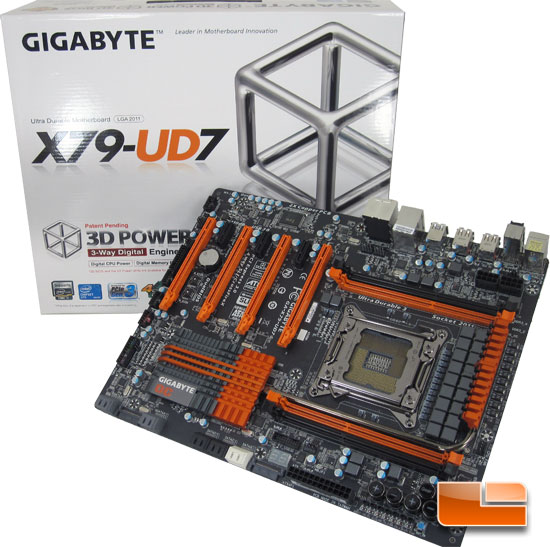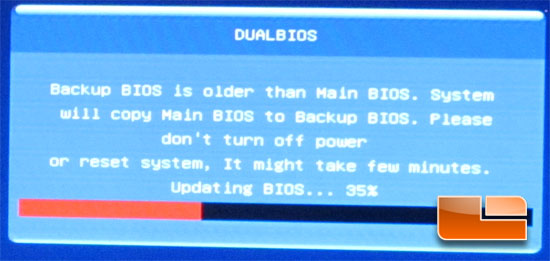GIGABYTE GA-X79-UD7 Motherboard Review
Final Thoughts and Conclusion

The GIGABYTE GA-X79-UD7 isn’t aimed at the budget minded individual. It currently carries a price tag of $369.99 plus shipping. Are you getting what you pay for? In short, absolutely. The GIGABYTE GA-X79-UD7 is packed full of features that make it worth every one of your hard earned dollars. GIGABYTE has made some very solid improvements over the previous generation of Sandy Bridge motherboards that simply add to the overall package. My personal favorite is the addition of the GIGABYTE 3D BIOS. The GIGABYTE 3D BIOS was very easy to use and navigate through. Whether you use the board layout and select which area you want to tweak, or the more traditional style BIOS that you can navigate through and find the settings you want to work on. It was a pleasure to work in. With that being said, there were a few quirks in the 3D BIOS that we discovered during our testing today.
The Legit Reviews test bench uses a Razer Copperhead mouse. The Razer Copperhead mouse is a bit on the dated side and was cycled out of office computer and replaced with a Logitec G5 gaming mouse. What we noticed in the 3D BIOS was that with the original F2 BIOS when the GIGABYTE GA-X79-UD7 was fired up for the first time we didn’t have the ability to use the Razer Copperhead mouse. This wasn’t a deal breaker for me, as I still tend to click through the BIOS using the arrow keys on the keyboard. When I went to enter the Q-Flash to update the BIOS to the latest F8 BIOS revision, I couldn’t get to the Q-Flash icon without using the mouse. That did frustrate me a little bit. If this had been installed into a case and tucked into a desk I would have had to pull it out, unplug the Razer Copperhead and try a different mouse. Fortunately running the GIGABYTE GA-X79-UD7 on the test bench this wasn’t an issue, for some though I could see it being an issue, or at least a project. Fortunately there are plenty of mice to choose from around here. The closest USB mouse was the Logitec G5 gaming mouse in the office computer. Once we plugged that into the GIGABYTE GA-X79-UD7 we had full mouse control in the 3D BIOS. If we didn’t have a second mouse readily available we would have had to use an alternate method to flash the BIOS. We’ve used the GIGABYTE @BIOS in the past without fail, but after I bricked a couple of different boards (none in recent years) using windows flash utilities in the past that’s one way I try to avoid flashing the BIOS. Now that we were able to update the BIOS to the F8 revision we put the right mice where they belong and fired the GIGABYTE GA-X79-UD back up and headed back into the BIOS. The Razer Copperhead would now move the mouse cursor, but it wasn’t orientated right, try and move it up and it would go right, down and left. I did end up just navigating through the 3D BIOS with the keyboard, it would have been nice to have the mouse available to me though.

Once we flashed the GIGABYTE GA-X79-UD7 primary BIOS and rebooted the machine, we were presented with a message stating the backup BIOS is older than the Main BIOS. The GIGABYTE GA-X79-UD7 automatically updated the backup BIOS chip with the new BIOS. It would have been preferable to keep the original BIOS flash on the backup chip in the event that there was an issue with the new BIOS. It’s a little quirk, but definitely one worth pointing out.
Performance across motherboards today doesn’t very a whole lot. When looking at gaming performance, today’s games rely heavily on the graphics card, CPU intensive tasks rely on the the CPU and memory. We don’t see much variation in our scores during testing. With that being said, there is some deviation. Mostly due to the board design and power delivery methods, and trace routes. Our gaming performance today put the GIGABYTE GA-X79-UD7 right between the ASUS Rampage IV Extreme and the ECS X79R-AX. Ironically, this is also where the $369.99 plus shipping price point happens to fall. The ASUS Rampage IV Extreme retails for $425.23 and the ECS X79R-AX retails for $289.99. There just may be something to the old racing analogy: How fast do you want to go and how much do you want to spend. If you want an open box Gigabyte X79-UD7 you can get one from Newegg for $330.99 shipped.
In our past Intel X79 motherboard reviews we have had luck pushing our Intel Core i7 3960X up to 4.9GHz. today we weren’t as fortunate. We were only able to bring the Core i7 3960X Sandy Bridge-E CPU to 4.6GHz this time around. GIGABYTE has really changed up their BIOS with the new GIGABYTE 3D BIOS, I’m going to attribute our overclock to lack of experience with the new 3D BIOS. I don’t doubt that the GIGABYTE GA-X79-UD7 has more to give than we were able to get out of it today.
Late in the testing of the GIGABYTE GA-X79-UD7 Intel X79 motherboard we discovered that the supply of the GIGABYTE X79-UD7 was getting slim. It turns out that the GIGABYTE GA-X79-UD7 is a limited edition motherboard. It currently looks as if it is sold out according to GIGABYTE. I didn’t notice this on the packaging for the X79-UD7, or anywhere on the GIGABYTE website. When the GIGABYTE GA-X79 series was released, there was an issue with the power phase design. Some of the boards where seeing a hardware failure during overclocking. The power phase design would overheat and see a catastrophic failure. GIGABYTE released the F7 revision of the BIOS to solve the issue. Once the F7 revision of the BIOS had been released GIGABYTE posted a video of Hi Cookie breaking the world record on the GIGABYTE GA-X79-UD3 Intel X79 motherboard.
I still have alot of faith in the GIGABYTE GA-X79-UD7 motherboard, it ran great for me throughout our testing. It does make on wonder when a top tier motherboard like the GIGABYTE GA-X79-UD7 disappears from the retail channel. If you do manage to get your hands on the GIGABYTE GA-X79-UD7, you can still have some peace of mind. The GIGABYTE GA-X79-UD7 is backed by a five year warranty from GIGABYTE.

Legit Bottom Line: The GIGABYTE GA-X79-UD7 proved itself to be a very capable motherboard that handled everything we threw at it with ease. I would easily recommend the GIGABYTE GA-X79-UD7 to anyone looking to put together an Intel X79 LGA2011 system!

Comments are closed.